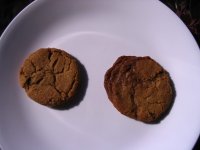Some Wisdom about Cookies and Cookie Dough
Since Alton Brown did his Good Eats episode years ago entitled, “Three Chips for Sister Marsha,” in which he explains the effect different ingredients have on a cookie recipe, others have jumped on the bandwagon. I have compiled a few unattributed and out of context comments here. Maybe some day I’ll come back and dissertate in an organized fashion.
Underbaking cookies produces a chewier product, something that seems to be all the rage in America since the 1970s. The phenomenon of “cookies and milk,” however, arose from properly baking cookies until golden brown, crisper and with a heightened taste by reason of the caramelization (evidenced by the color). This made the addition of creamy milk all the more pleasurable, the cookie equivalent of ice cream added to make a serving of pie à la mode.
This is what cookies used to be. In fact, the name derives from the fact that they were thoroughly—not halfway—baked. In British English and in French, the word for cookie is biscuit, which means “twice-baked.”
Creaming cold fat and sugar puts tiny air bubbles into dough making it cakey. The air spaces are created by the sharp edges of sugar crystals cutting through the fat which, if cold, retains its shape.
Cutting cold fat or butter into flour creates cumbly, shortbread cookies.
Melted butter makes chewy cookies because water separates out from the butter (80% fat, 20% water) and absorbs into the flour forming gluten.
Egg whites dry out a dough; to add more egg to the dough, add just the yolk.

For a craggy, large crumb (like peanut butter cookies), use baking soda; baking powder makes a tighter crumb (decorative sugar cookies). The cookie I made at the left is a coarse-crumb brown sugar cookie.
When making cookies with high melted butter and high sugar content, mix well because otherwise you’ll get caramelization in one place and cake in another (like the cookie on the right) and not a homogeneous texture (like the cookie on the left).